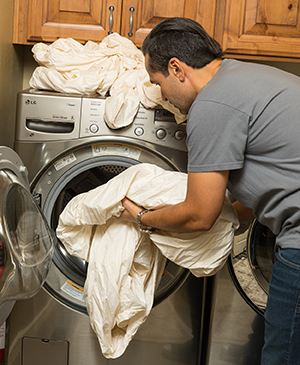Controlling Allergens: Dust Mites
Being around allergens all of the time means you always have allergy symptoms. That’s why it's important to control or stay away from the allergens that cause your symptoms. The tips below can help limit dust mites if you're allergic to them.
Dust mite allergy
Dust mites are a common cause of allergies that affect your nose. These mites are tiny bugs. They live in mattresses, box springs, pillows, bedding, upholstered furniture, and carpets. They live in warm, humid places.
Dust mites are normal and almost impossible to get rid of. But you can keep them under control.
Make changes to your home
Furniture such as sofas and chairs hold dust mites. To reduce the problem:
-
Choose nonfabric upholstery such as leather or vinyl.
-
Replace horizontal blinds with pull-down shades or vertical blinds.
-
Use washable curtains instead of heavy drapes.
-
Have as little carpeting as possible. Use area rugs or throw rugs that can be washed, if possible.
-
Cover your mattress, box spring, and pillows in allergy-proof casings.
Housecleaning
 |
| Wash all bedding in hot water. |
Here are some tips:
-
Wash sheets, blankets, and mattress pads every week in hot water. This means at least 130°F (54.4 C).
-
Remove stuffed animals and other things in the bedroom that collect dust. This includes wall hangings, knickknacks, and books.
-
Dust your home every week with a damp cloth. Vacuum once a week. Use HEPA (high efficiency particulate air) filters. Or use 2-ply bags in the vacuum cleaner. Or use a vacuum designed to reduce allergens.
-
Have someone else dust and vacuum for you. If that's not possible, wearing a filter mask while you clean may help.
Reduce indoor humidity
Dust mites need moist air to live. Use a dehumidifier to reduce air moisture. Don’t use humidifiers or vaporizers. Keep the humidity in your house at 40% to 50%. You can check this with a device called a hygrometer.
Talk with your healthcare provider about other ways to reduce dust in your home. Ask about medicines that can help with your allergy symptoms.
Online Medical Reviewer:
Heather M Trevino BSN RNC
Online Medical Reviewer:
Melinda Murray Ratini DO
Online Medical Reviewer:
Rajadurai Samnishanth Researcher
Date Last Reviewed:
4/1/2024
© 2000-2024 The StayWell Company, LLC. All rights reserved. This information is not intended as a substitute for professional medical care. Always follow your healthcare professional's instructions.